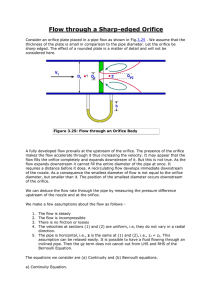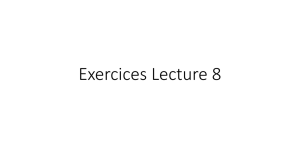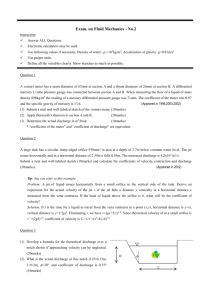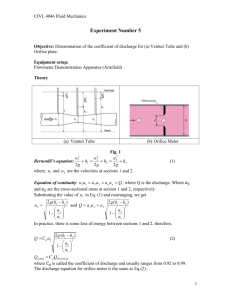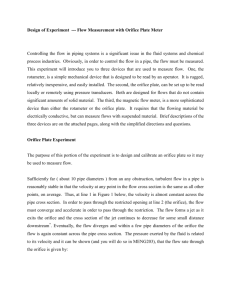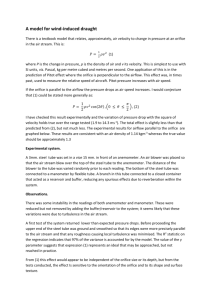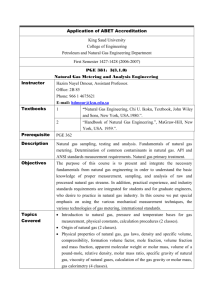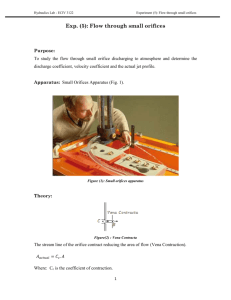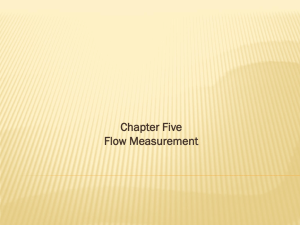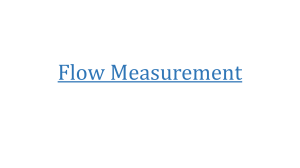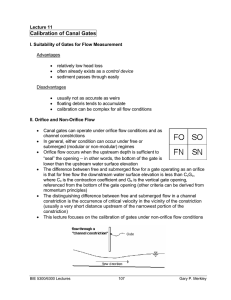FLUID MACHANICS I_030410033104_1
advertisement
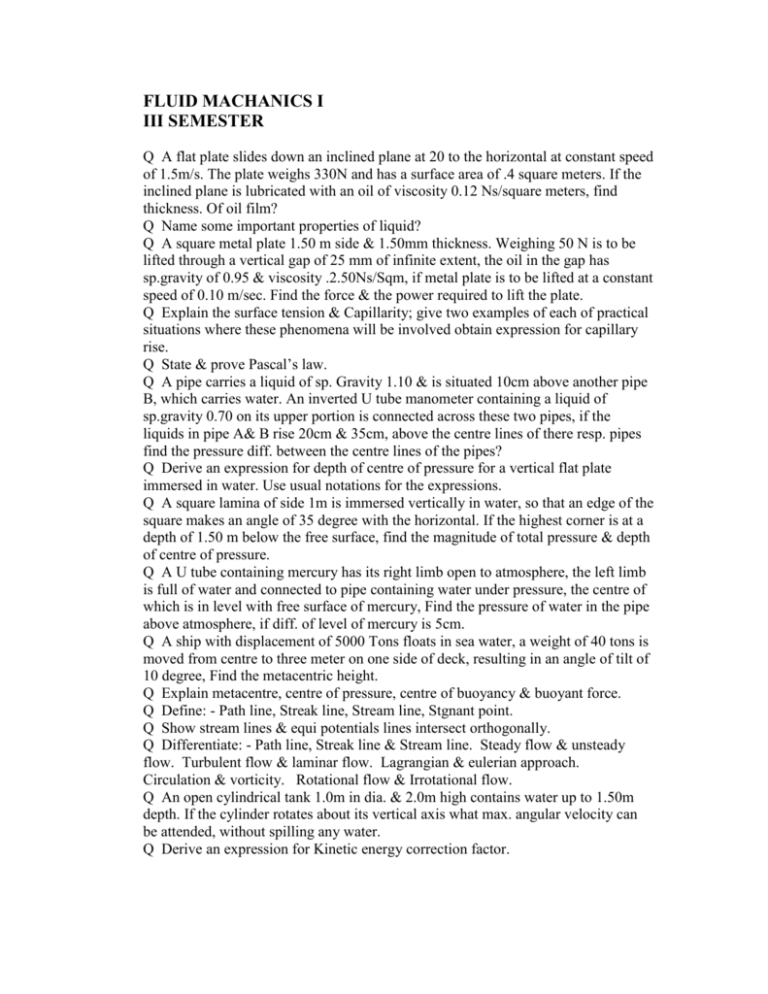
FLUID MACHANICS I III SEMESTER Q A flat plate slides down an inclined plane at 20 to the horizontal at constant speed of 1.5m/s. The plate weighs 330N and has a surface area of .4 square meters. If the inclined plane is lubricated with an oil of viscosity 0.12 Ns/square meters, find thickness. Of oil film? Q Name some important properties of liquid? Q A square metal plate 1.50 m side & 1.50mm thickness. Weighing 50 N is to be lifted through a vertical gap of 25 mm of infinite extent, the oil in the gap has sp.gravity of 0.95 & viscosity .2.50Ns/Sqm, if metal plate is to be lifted at a constant speed of 0.10 m/sec. Find the force & the power required to lift the plate. Q Explain the surface tension & Capillarity; give two examples of each of practical situations where these phenomena will be involved obtain expression for capillary rise. Q State & prove Pascal’s law. Q A pipe carries a liquid of sp. Gravity 1.10 & is situated 10cm above another pipe B, which carries water. An inverted U tube manometer containing a liquid of sp.gravity 0.70 on its upper portion is connected across these two pipes, if the liquids in pipe A& B rise 20cm & 35cm, above the centre lines of there resp. pipes find the pressure diff. between the centre lines of the pipes? Q Derive an expression for depth of centre of pressure for a vertical flat plate immersed in water. Use usual notations for the expressions. Q A square lamina of side 1m is immersed vertically in water, so that an edge of the square makes an angle of 35 degree with the horizontal. If the highest corner is at a depth of 1.50 m below the free surface, find the magnitude of total pressure & depth of centre of pressure. Q A U tube containing mercury has its right limb open to atmosphere, the left limb is full of water and connected to pipe containing water under pressure, the centre of which is in level with free surface of mercury, Find the pressure of water in the pipe above atmosphere, if diff. of level of mercury is 5cm. Q A ship with displacement of 5000 Tons floats in sea water, a weight of 40 tons is moved from centre to three meter on one side of deck, resulting in an angle of tilt of 10 degree, Find the metacentric height. Q Explain metacentre, centre of pressure, centre of buoyancy & buoyant force. Q Define: - Path line, Streak line, Stream line, Stgnant point. Q Show stream lines & equi potentials lines intersect orthogonally. Q Differentiate: - Path line, Streak line & Stream line. Steady flow & unsteady flow. Turbulent flow & laminar flow. Lagrangian & eulerian approach. Circulation & vorticity. Rotational flow & Irrotational flow. Q An open cylindrical tank 1.0m in dia. & 2.0m high contains water up to 1.50m depth. If the cylinder rotates about its vertical axis what max. angular velocity can be attended, without spilling any water. Q Derive an expression for Kinetic energy correction factor. Q A pipe line having a length of 6m between section A(diameter 100mm) and section B(diameter 300mm) is inclined at an angle of 20 upwards with horizontal with section A at lower level. If the velocity of flow of water is 1.8m/s at section A upwards and headloss between two sections is 5cm, determine the difference of pressures between the two sections. Q A 300 mm diameter pipe carries water under a head of 20m with a velocity of 3.5m/s If the axis of the pipe turns horizontally through 45 find the magnitude and direction of resultant force at the bend Q Define hydraulic coefficient. For an orifice and establish a relationship between them. Q A tank containing water is provided with a sharp edged circular orifice of 7.5mm diameter .The height of water in the tank is 1.44m above the orifice. The jet strikes the wall 1.5m away and 0.42m below the centre line of the contracted section of the jet. The actual discharge through the orifice is measured to be 35 liters in 4 minutes. Determine 1 The orifice coefficients (Cc ,Cv ,Cd ,and Cr) 2 The power loss at the orifice. Q Obtain an expression for absolute pressure head at vena contracta for an external cylindrical mouthpiece discharging freely under a constant head. Q what is a Cipolletti weir? Show that it is given a proper side slope for a specific purpose. Q A 40m long broad crested weir has 0.4meter height of water above its crest. Find the maximum discharge. Take Cd=0.6 and neglect velocity of approach. Q State Bernaulis theorem. Also write the applications and limitations of above Theorem. Q A pipe carrying water tapers from cross section of 0.4 square meters at A to 0.25sqm at B The average velocity at A is 1.6m/s and the pressure is 441 KN/square meters. If the frictional effect is negligible, determine the pressure at B which is 7.2m above the level of A Q A venturimeter with 20 cm diameter inlet and 10 cm throat is used for measuring flow of oil of specific gravity 0.9. The oil mercury differential gauge shows a reading of 30 cm assuming the coefficient. Of meter 0.98, calculate the discharge. Q Prove that the error in discharge due to error in the measurement of head over a triangular notch or weir is given by dQ/Q = 5/2*dH/H Where Q – Discharge through the triangular notch, H – Head over the triangular notch Q A discharge of 0.15 cum/sec was measured over V notch under a constant head of 1.0 meter. Determine the percentage error in the measurement of discharge, if an error of 10 mm has taken place while measuring the head of water. Q Explain jet measurement method of determination of coefficient of velocity of an orifice. Q A 40mm diameter. Orifice in the vertical side of a tank discharges water, the water surface of the tank is at a constant level of 2.0m above the centre of the orifice. If the head loss in the orifice is 0.20 m & coefficient. Of contraction is 0.63. Determine:-1) coefficient. Of velocity & coefficient. Of discharge. 2) The discharge through the orifice 3) the location of point of impact of the jet on horizontal. Plane located 0.50 m below the centre of orifice. Q Differentiate bet. 1) Large orifice & small orifice 2) Free discharging orifice & drown orifice 3) Mouth piece running full & running free. Q. Obtain an expression for discharge through a large rectangular orifice, define Cv, Cc,Cd & establish a relation ship bet. Them. Q A flow of water in a channel varies 100 lit/sec. to 500lit/sec, it is desired to measure the discharge in the channel with an accuracy of 0.50 percent through out the entire range. The water surface elevation could be measured to an accuracy of 0.50 mm. if the sharp rested weir is used for discharge measurement what is the maxi. Length of weir to satisfy the above requirement, Assume Cd = 0.62, & neglect velocity of approach. Q What do you mean by dimension less number? Derive the expression for 1) Reynolds no. 2) mach no. Q Explain the term Dimensional Homogeneity. Q state Bucking ham pi theorem, what is its utility? Q State impulse momentum principle. Q What is Froude’s no.? Derive the expression for the same & explain its significance & application in model studies.
